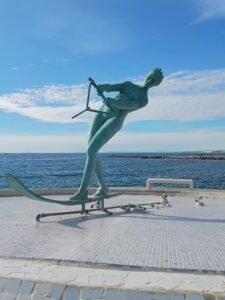1. Málaga:
Málaga is more than just a place to fly to before exploring Andalucia. The city was once the home of Pablo Picasso, but it’s now a cultural center, and that means more than just museums dedicated to the legendary artist.
First, check out performances at the Cervantes Theater, a must-see for both local flamenco stars and international ballet legends. But it’s not just happening in city centres. The town beach, La Malagueta, is perfect for a midday snack, enjoying a delicious lunch at one of Chiringuitos, a beach restaurant where seafood is grilled over hot coals right in front of you. .

2.Ibiza city:
Ibiza is renowned as one of Europe’s glitziest party destinations, but Ibiza Town, the capital of the Balearic Islands, offers much more than raves, 24-hour clubs and spring break study abroad holidays.
Let’s start with Dalt Villa, a fortified medieval old town perched on a hill with stunning views of the Mediterranean and a 16th-century battlements. It is also a UNESCO World Heritage Site. Meanwhile, you can also visit the excavated cemetery called Puig de Molen.

Located on Andalusia’s Costa del Sol, Marbella is famous not only for its megayachts and supercars, but also as a summer retreat for the European elite. But if you step outside the main tourist attractions, it becomes a whole new city.
The labyrinth of the Old Town winds around the Plaza de los Naranjos, a square named after the orange tree at its center. Stroll through the collection of Salvador Dali sculptures on public display on Avenida del Mar and follow the seaside promenade to the nearby town of San Pedro de Alcantara. This is the real Marbella, not the glitz and glamor that grabs the headlines.

4.Sitges:
You don’t have to go beyond Barcelona to explore the lesser-visited coastal regions of Catalonia. Stiges, a 45-minute drive from the city, was the center of the Spanish counter-culture movement in the 1960s and remains a hub for artists today.
Every year it hosts the Sitges Cultural Festival (all kinds of live classical and contemporary music), the International Film Festival (horror and fantasy films), the Sitges Carnival (one of the liveliest carnivals in the world) and the Gay Pride Festival. (The city is known for being gay-friendly.) It doesn’t hurt that the Stygians enjoy a consistently mild climate sheltered in the Garaf Mountains.

5 .Cadaques:
At Spain’s easternmost point on the Costa Brava, the remote Mediterranean village of Cadaques is a long way from the Greek islands. “This is a charming whitewashed village where Dali lived for many years with his wife and muse Gala.
Today the city is more vibrant than it was a few decades ago, but it’s not snobbish,” says Spain travel expert Pablo Calvo. “With a vibrant culture and environment, wildlife and clear waters, it’s a great place to relax, eat, write and get lost.” Salvador Dali’s house, the oceanfront residence where the Surrealist lived for 50 years, is truly a tourist attraction; Note the large white sculptured egg on the roof. But Dali wasn’t the only famous artist to spend time in the city. Its sparkling blue seas and bright sunshine also inspired Picasso, Magritte and Matisse.

Number 6.Tenerife:
Tenerife is the largest of the seven Canary Islands off the northwest coast of Africa. Holidaymakers have been flocking to this volcanic island for years, but today astro tourism is the most prominent attraction. The astronomical observatory at the top of Teide Volcano offers spectacular views of space due to the lack of light pollution in the area.
If you don’t like the telescope crowd, fear not. A bit of a party spot, there is plenty of drinking during the day (and night) by the pool, bar and beach. In the island’s capital, Santa Cruz de Tenerife, Calle Antonio Dominguez Alfonso has some of the best nightlife options, including Los Reunidos Tapas and Copas.

Number 7.Ribadesella:
The rugged beauty of Spain’s northern coast is an open mystery, exemplified by Ribadesella. In addition to Cueva de Tito Bustillo, a UNESCO World Heritage Site, the Asturian fishing village, the country’s largest producer of cider, is also a culinary destination. “For me, Asturias is the best breath of fresh air in the hot Spanish summer,” says Lorraine Alois, CEO of Spanish gastronomic company Devore Tours.
“It feels far away from the hustle and bustle of life in Madrid, and the weather is usually wonderful (in the summer).” As for tasting the local cuisine, she puts together a midday meal. Recommends visiting a winery to dine in. He often goes to Cideria Carruccio to enjoy sardines with oysters, ham and padron peppers.

